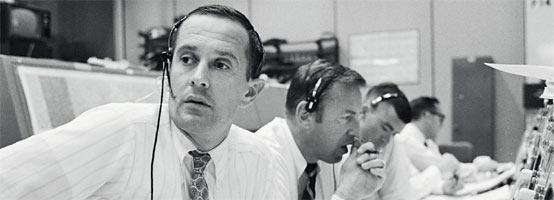|
Were
flight operations to be part of the design center, MSC in
Houston, or part of the operations center at Kennedy Space
Center in Florida where Mercury controls were housed? Goddard
Space Flight Center in Maryland had the attraction of being
conveniently located near the nation's capital and NASA
Headquarters. Would travel requirements be greater or less if
the control center were located in Maryland, Texas or Florida?
It was soon decided that mission control and operations would
become a major component of MSC responsibilities.

Overall view of the Mission
Operations Control Room in the Mission Control Center during
the first day of the Gemini V flight.
"Discussions among MSC management quickly recognized
that operations requirements would be a critical factor in the
design of all manned spacecraft," said former JSC Director Dr.
Christopher C. Kraft. "Therefore the location of the
astronauts and the flight operations engineers adjacent to the
engineers responsible for the management of the aerospace
companies building the hardware became a highly desirable
requirement. Also it was recognized that once the launch had
taken place, the location of a control center on Earth was not
a significant factor. Considering these factors, it was
decided that the best location for a Mission Control Center
and the facilities for training the astronauts would be with
the Manned Spacecraft Center in Houston."
The MCC
enables the flight control team to perform its critical
duties. With the knowledge of the Mercury experience and a
vision of what Gemini and Apollo would require, designers and
developers began defining the parameters of the MCC in Houston
along with its network, recognizing that its hardware would
evolve over the years.

Spacecraft communicators are
pictured as they keep in contact with the Apollo 11 astronauts
during their lunar landing mission on July 20, 1969. From left
to right are astronauts Charles M. Duke Jr., James A. Lovell
Jr. and Fred W. Haise Jr.
Construction of the control center began in late 1962.
Evolution of the concept of a control center continued
throughout the Apollo Program. Floor space was allocated for
representatives of the spacecraft program office who, along
with JSC engineering and vehicle contractors, supported each
mission. This increased presence strengthened the
problem-solving capabilities of the MCC team. The spacecraft
program office support team occupied what became known as the
"SPAN" or Spacecraft Analysis Room. JSC and industry
engineering teams supported missions in this room. This
arrangement allowed immediate contact with key JSC engineering
and industry representatives in case assistance were needed in
resolving any technical anomalies that might arise during
missions.
"Here we
move from a system with virtually no computing capability,
totally analog, only two systems console with couple dozen
meters, and two TVs to now where-miracle of miracles!-we had
TVs on all the consoles," said Eugene Kranz, former director
of JSC's Mission Operations Directorate. "We could look at our
data on television. All of the computers we had were large,
centralized systems at that time because the desktop-systems,
small computers we use nowadays just did not exist. But, the
systems that we used now allowed us to process data, to string
the data together. So we had in Gemini the merging of two
worlds. We had this new world of the Mission Control Center,
Houston, but it was still tied to the old world of the
network. Because worldwide communications didn't exist at that
time, we still got tracking information by low-speed teletype,
and we got summary messages."

Prototype of the "mail box"
constructed at the Manned Spacecraft Center to remove carbon
dioxide from the Apollo 13 Command Module is displayed in the
Mission Control Center. The 'mail box' was constructed when it
became apparent that carbon dioxide was prevalent in the
Command Module and the spacecraft's lithium hydroxide system
was not removing it sufficiently. Looking at the "mail box"
are, from left: Milton Windler, shift 1 flight director; Dr.
Donald (Deke) Slayton, director of flight crew operations,
MSC; Howard Tindall, deputy director, flight operations, MSC;
Sigurd Sjoberg, director, flight operations, MSC; Dr.
Christopher Kraft, deputy director, MSC; and Dr. Robert
Gilruth, director, MSC.
Houston's
initial MCC directed that Gemini IV flight and all subsequent
Gemini and Apollo flights and some space shuttle flights. The
original MCC working life began with the first space walk
during that Gemini mission in June 1965 and ended in March
1996 with the launch of STS-76, which saw the first space walk
of U.S. astronauts outside of the Russian Mir space
station. |





